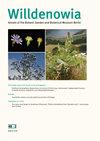Orbilia jesu-laurae (Ascomycota, Orbiliomycetes), a new species of neotropical nematode-trapping fungus from Puerto Rico, supported by morphology and molecular phylogenetics
IF 1.4
3区 生物学
Q2 PLANT SCIENCES
引用次数: 4
Abstract
Orbilia jesu-laurae is a new species of nematode-trapping fungus found on decorticated angiosperm wood in a tropical rainforest in Puerto Rico. The single specimen was studied from fresh apothecia and cultures. Morphology was studied and phylogenetic analysis (rDNA: ITS and LSU) was conducted using both sexual and asexual morphs. Nematodes were added to cultures to verify the formation and morphology of the trapping structures. Our results show that the species is in the Arthrobotrys clade, the phylogenetically closest relative being a possibly Mexican genotype with unknown morphology, erroneously referred to as Arthrobotrys musiformis in GenBank. Macro- and micromorphological, ecological and biogeographic data are provided along with a discussion of closely related species.Citation: Quijada L., Baral H.-O., Beltran-Tejera E. & Pfister D. H. 2020: Orbilia jesu-laurae (Ascomycota, Orbiliomycetes), a new species of neotropical nematode-trapping fungus from Puerto Rico, supported by morphology and molecular phylogenetics. – Willdenowia 50: 241–251.Version of record first published online on 2 June 2020 ahead of inclusion in August 2020 issue.Orbilia jesu laurae(子囊菌门,Orbiliomycetes),一种来自波多黎各的新热带线虫捕获真菌,由形态学和分子系统发育学支持
Orbilia jesu laurae是一种新的线虫捕获真菌,发现于波多黎各热带雨林的去壳被子植物木材上。单个标本是从新鲜的古猿和培养物中研究的。对形态学进行了研究,并利用有性和无性形态进行了系统发育分析(rDNA:ITS和LSU)。将线虫加入培养物中以验证捕获结构的形成和形态。我们的研究结果表明,该物种属于Arthrobotrys分支,系统发育上最接近的亲缘关系可能是一个形态未知的墨西哥基因型,在GenBank中被错误地称为Arthrobodrys musiformis。提供了宏观和微观形态、生态和生物地理学数据,并讨论了密切相关的物种。引文:Quijada L.,Baral H.-O.,Beltran Tejera E.&Pfister D.H.2020:Orbilia jesu laurae(子囊菌门,Orbiliomycetes),一种来自波多黎各的新热带线虫捕获真菌,得到形态学和分子系统发育学的支持Willdenowia 50:241–251。该记录的版本于2020年6月2日首次在线发布,随后将于2020年8月出版。
本文章由计算机程序翻译,如有差异,请以英文原文为准。
求助全文
约1分钟内获得全文
求助全文
来源期刊

Willdenowia
PLANT SCIENCES-
CiteScore
4.60
自引率
5.30%
发文量
17
审稿时长
>12 weeks
期刊介绍:
Willdenowia is an international peer-reviewed journal publishing original research articles in English from the entire fields of plant, algal and fungal systematics, covering the evolution, taxonomy and nomenclature of these organisms as well as related fields such as floristics and plant geography. Articles on phylogeny and molecular systematics are especially welcome, as are review articles. Descriptions of new taxa may be considered, but only if supported by robust evidence. Narrowly regional studies of widespread taxa, routine typifications, checklists and new floristic records are generally not considered (excluding contributions to the Euro+Med-Checklist Notulae). Authors are encouraged to deposit duplicates of their material, especially nomenclatural types, in the Berlin herbarium (B).
 求助内容:
求助内容: 应助结果提醒方式:
应助结果提醒方式:


